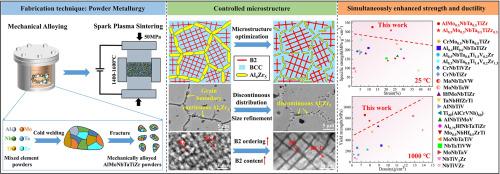Simultaneously enhancing strength and plasticity in AlMoNbTaTiZr refractory high-entropy alloys via powder metallurgy
IF 14.3
1区 材料科学
Q1 MATERIALS SCIENCE, MULTIDISCIPLINARY
引用次数: 0
Abstract
This study presented a powder metallurgy (PM) strategy combining mechanical alloying (MA) and spark plasma sintering (SPS) for fabricating the high-performance AlMoNbTaTiZr refractory high-entropy alloys (RHEAs), which are composed of BCC phases, ordered B2 phases and grain boundary Al4Zr5 intermetallics. By optimizing ball milling processes, SPS sintering temperatures, and Al/Zr content, a relatively high content of B2 phase with a high degree of structural ordering and desired discontinuous Al4Zr5 intermetallics at grain boundaries was achieved. And it was noteworthy that the average grain size of AlMo0.5NbTa0.5TiZr RHEA was only 14.8 μm, an order of magnitude smaller than that of as-cast AlMo0.5NbTa0.5TiZr RHEA. These endowed the PM AlMo0.5NbTa0.5TiZr RHEAs with a low density (7.4 g/cm3) and significantly improved mechanical properties, especially at 1000°C, with the yield strength of 853 MPa and compressive strength of 929 MPa. Moreover, with a decrease in the content of Al and Zr elements, the yield strength, fracture strength and fracture strain at room temperature for the present PM Al0.5Mo0.5NbTa0.5TiZr0.5 RHEA were up to 2408 MPa, 2783 MPa and 20.8%, which were approximately 400 MPa and 108% higher than that of as-cast AlMo0.5NbTa0.5TiZr RHEA, respectively. More importantly, the specific strengths of present PM AlMo0.5NbTa0.5TiZr and Al0.5Mo0.5NbTa0.5TiZr0.5 RHEAs were far higher than that of publicly reported Ni-based superalloys, particularly above 1000°C, having a potential for partial substitution of conventional Ni-based superalloys to meet the dual demands for aerospace’s weight reduction and performance improvement. Finally, the microstructure evolution characteristics and strengthening-toughening mechanisms of PM AlMo0.5NbTa0.5TiZr RHEAs were discussed.

同时通过粉末冶金提高AlMoNbTaTiZr耐火高熵合金的强度和塑性
采用机械合金化(MA)和火花等离子烧结(SPS)相结合的粉末冶金(PM)方法制备了由BCC相、有序B2相和晶界Al4Zr5金属间化合物组成的高性能AlMoNbTaTiZr耐火高熵合金(RHEAs)。通过优化球磨工艺、SPS烧结温度和Al/Zr含量,获得了较高含量的B2相,具有较高的有序度和晶界不连续的Al4Zr5金属间化合物。值得注意的是,AlMo0.5NbTa0.5TiZr RHEA的平均晶粒尺寸仅为14.8 μm,比铸态AlMo0.5NbTa0.5TiZr RHEA小一个数量级。这使得PM AlMo0.5NbTa0.5TiZr RHEAs具有低密度(7.4 g/cm3)和显著改善的力学性能,特别是在1000℃时,屈服强度为853 MPa,抗压强度为929 MPa。随着Al和Zr元素含量的降低,现态PM Al0.5Mo0.5NbTa0.5TiZr0.5 RHEA的屈服强度、断裂强度和室温断裂应变分别达到2408 MPa、2783 MPa和20.8%,比铸态AlMo0.5NbTa0.5TiZr RHEA分别提高了约400 MPa和108%。更重要的是,目前的PM AlMo0.5NbTa0.5TiZr和Al0.5Mo0.5NbTa0.5TiZr0.5 RHEAs的比强度远远高于公开报道的ni基高温合金,特别是在1000°C以上,具有部分替代传统ni基高温合金的潜力,以满足航空航天减重和提高性能的双重需求。最后,讨论了PM AlMo0.5NbTa0.5TiZr RHEAs的显微组织演变特征和强化增韧机理。
本文章由计算机程序翻译,如有差异,请以英文原文为准。
求助全文
约1分钟内获得全文
求助全文
来源期刊

Journal of Materials Science & Technology
工程技术-材料科学:综合
CiteScore
20.00
自引率
11.00%
发文量
995
审稿时长
13 days
期刊介绍:
Journal of Materials Science & Technology strives to promote global collaboration in the field of materials science and technology. It primarily publishes original research papers, invited review articles, letters, research notes, and summaries of scientific achievements. The journal covers a wide range of materials science and technology topics, including metallic materials, inorganic nonmetallic materials, and composite materials.
 求助内容:
求助内容: 应助结果提醒方式:
应助结果提醒方式:


